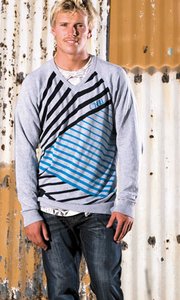La Jolla Group Redefines Action-Sports Business Model
The La Jolla Group’s relocation down the road this summer to a new 200,000-square-foot facility in Irvine, Calif., will be the latest in a series of calculated moves meant to put the apparel manufacturer at the forefront of the action-sports market. Home to the apparel licenses for O’Neill, Rusty, Metal Mulisha and Lost brands, La Jolla is on a growth track all its own.
“We’re ready to hit the gas,” said Toby Bost, La Jolla’s chief executive. Earlier this month, La Jolla made headlines when it announced a multi-tier distribution strategy for Rusty that includes an exclusive line for JCPenney. The deal calls for a Rusty-branded capsule of boardshorts, T-shirts and hoodies for young men to be sold in 600 JCPenney locations around the country beginning in July. A holiday collection will see the JCPenney offerings expand to flannel and denim pieces.
The deal, which will account for 50 percent of Rusty’s sales going forward, is expected to raise Rusty’s brand recognition among consumers. Currently, the brand’s core apparel is sold in approximately 300 key doors. “This is going to help us build a platform and inspire growth,” Bost said, adding that the strength of the new mass-market business will feed the continued development of core offerings.
O’Neill, which acts as La Jolla’s cornerstone, will see changes this year as well. Maria Barnes, a swimwear designer formerly of Quiksilver, joined La Jolla to head up its women’s swimwear program when it brings it back in-house, starting with the 2010 season. Tustin, Calif.–based Raj Manufacturing had been the longtime licensee of the O’Neill swim brand. The move, Bost said, will help create a more cohesive vision for O’Neill. “It will help us present a more unified voice with the rest of the collection. We’re very excited about it,” he said. Lost, Metal Mulisha and Rusty’s swimwear programs are all already in-house.Old roots, new ideas
Launched in 1992 as La Jolla Sport with the acquisition of the O’Neill Clothing license, the company later added Dysfunction to house the Lost Clothing license. Bost, who came up through the O’Neill ranks, said that nearly three years ago, the company was looking for an identity and new ways to grow. Growth came in the form of licenses for Metal Mulisha Clothing, a new freestyle-motocross brand, and Rusty North America, a heritage core-surf brand.
“That’s when we created La Jolla Group. We brought in other brands and built a powerful licensing company. Since then, business has really taken off,” Bost said. Today La Jolla boasts more than 320 employees, six retail locations and product in more than 3,000 retail locations across the country.
In 2007, sales revenues were up 25 percent and grew an additional 30 percent in 2008, Bost said. Despite the economic downturn, La Jolla expects to see its sales revenues grow 15 percent in 2009.
Bost attributed La Jolla’s strong performance to an out-of-the-box approach to action-sports apparel licenses.
“We’re a different kind of licensee. We think of La Jolla as a ’brand caretaker,’ and we treat our licenses like we own them,” he said. To create a cohesive vision for each brand, La Jolla handles marketing, sales, design, production and distribution for each of its brands, keeping the creative and sales portions separate for each brand while merging back-office, production, finance and distribution functions. “Brand identity is sacred and separate for our brands—we don’t cross-pollinate,” Bost said.
Technology, innovation and a youthful approach are hallmarks of action sports, Bost said, but are not necessarily embraced in the apparel industry that sprung up around surf, skate and motocross. “We want to build a 21st century organization that is young and dynamic and creative but that is also on the cutting edge of technology and has great operational systems in place,” he said. “A lot of brands are stuck in the old ways of doing business. We want be a revolutionary company that operates differently and moves the industry forward.”
The cavernous new La Jolla building—which will include a state-of-the-art distribution center and showroom, an on-site retail location, a half pipe, and a gym—will help define La Jolla as a new breed of company. “In the new space, we’ll be set for the next five years, during which we expect 22 percent growth annually,” Bost said.
Bost, who has presided over La Jolla’s growth spurt first as chief operating officer and now as chief executive, is himself revolutionary; he is one of the youngest chief executives in the industry.Room on the roster
Bost, who said that in the long term La Jolla may develop or buy its own brands, is also considering growing the company’s roster of licensed brands within the next six months to a year.
“We’re in the kicking tires phase right now on a few things,” he said, declining to name names.
“We’ve mastered the licensing strategy, and sometimes licensing partnerships are even better for brands [than acquisitions],” he said. “Let’s put it this way: Especially in this economy, if a brand is in need, where are they going to land?”























